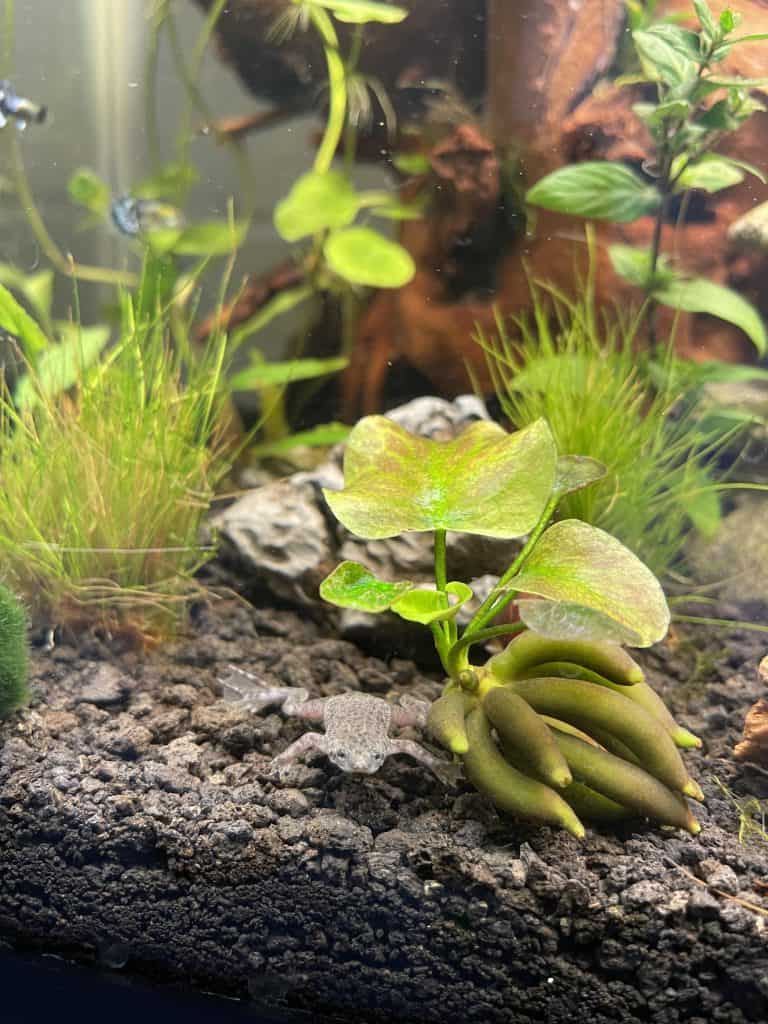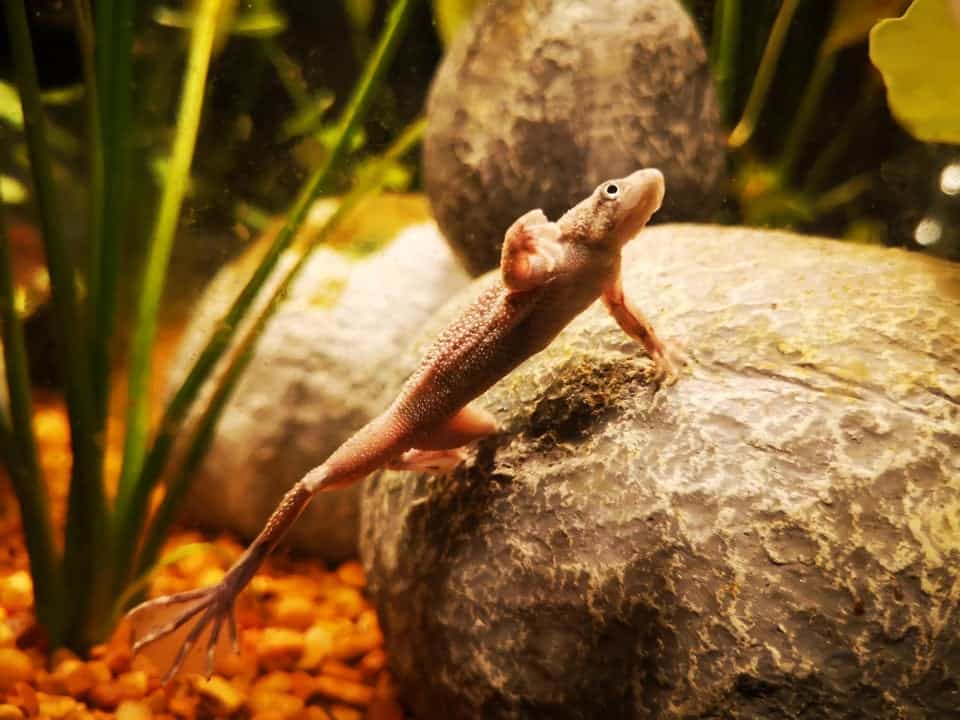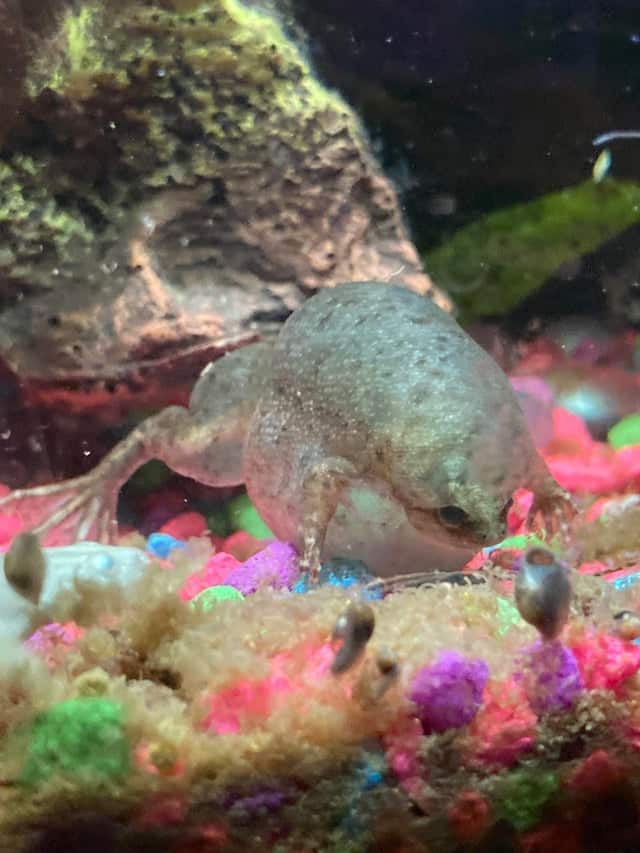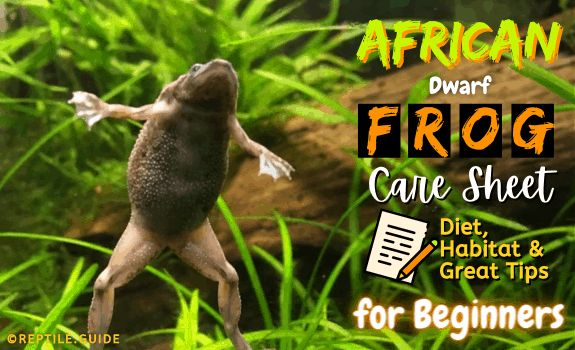African Dwarf Frogs (Hymenochirus species) are small, charismatic amphibians common within the pet trade.
They are popular with aquarium hobbyists due to their aquatic nature and compatibility with certain fish species.
These frogs are suitable for intermediate-level hobbyists. They do have specific care requirements that set them apart from other aquarium species.
This comprehensive guide will explain how to care for African dwarf frogs properly.
You will also learn about their biology and conservation.
In This Article
What You’ll Learn:
- Nutritional requirements
- Species that make suitable tank mates
- Background information about Hymenochirus species
- How to cycle your aquarium and prevent nitrogen buildup
- How to create the ideal aquarium setup for African dwarf frogs
- Common health problems – prevention and treatment (including a Chytrid fungus containment plan)
- & so much more!
African Dwarf Frog Background Info
Biology
African dwarf frogs are amphibians in the order “Anura” and the family “Pipidae.” They are native to equatorial regions of Africa, such as the Congo Basin.
The names “African dwarf frog” and “dwarf African clawed frog” actually refer to four species of the genus “Hymenochirus”:
- Gaboon dwarf frog – Hymenochirus feae
- Zaire dwarf frog – Hymenochirus boettgeri
- Western dwarf frog – Hymenochirus curtipes
- Eastern dwarf frog – Hymenochirus boulengeri
The main difference between species is their geographic range. They are all fairly similar in terms of appearance and ecology.
Members of this genus inhabit shallow pools and slow-moving inland waters. Despite being fully aquatic, they lack gills and must regularly surface for air.
Both adults and larvae (tadpoles) of each species are predatory. Their diet consists primarily of aquatic invertebrates and fish fry.
Rather than using a specialized tongue (like most frogs), they engulf prey using a suction-feeding technique.
The average life expectancy of these frogs is around five years in captivity. Some individuals can survive much longer.
Fun Fact: Dwarf clawed frogs possess a “lateral line,” similar to that of fish. This organ allows them to sense vibrations in the water column.
Behavior
Dwarf frogs are animated and entertaining to watch.
Don’t be too surprised if your frog seems to be acting “weird.” They are quite unusual creatures and have a range of behaviors.
Frogs may float motionless near the surface – or even upside down – for periods of time. This behavior is known as “burbling” and is nothing to worry about.
They will also dart up and down in the water column to breathe.
If you’re lucky, your frogs may even “sing!” Their noises resemble a quiet “hum” or a “buzz.” Males use this sound to attract mates.
Conservation
Not a whole lot is known about the conservation status of these animals.
Only the western dwarf frog (H. curtipes) has a formal IUCN Red List designation. As of 2022, this species is classified as “Least Concern.”
Population trends are yet unknown, but the species occurs within at least one formally protected area. At least some breeding individuals are likely to be protected from habitat loss and poaching.
All species – particularly the Zaire dwarf frog (Hymenochirus boettgeri) – have become wildly popular in the pet trade throughout recent years.
Little is known about the sustainability of current harvesting practices.
Identification – Avoiding Lookalikes
Dwarf frogs (Hymenochirus species) can easily be mistaken for African clawed frogs (Xenopus species). This misidentification is a common mistake made by many aquarists.
Unfortunately, this can be more than a harmless mix-up. Clawed frogs grow much larger than dwarf frogs and are aggressive feeders. They will eat virtually anything that fits in their mouths (including all of your aquarium fish).
Both genera are fully aquatic and belong to the family “Pipidae.”
The most obvious difference between clawed frogs and dwarf (or “dwarf clawed”) frogs is their size. Clawed frogs can grow up to five inches long!
Dwarf frogs are much smaller. They rarely exceed two inches in length, but can reach three inches.
Another key difference between the frogs is their front feet. Only dwarf frogs have webbed “fingers.” Clawed frogs’ fingers are not webbed.
Purchasing a Healthy Frog
Due to an overall lack of data concerning their status in the wild, amphibian owners must purchase responsibly.
The best way to do this is to always buy from a reputable local breeder or specialist store. Ask them about the origin of their animals and always buy captive-bred specimens.
It can be helpful to check out forums (such as r/Frogs, OurReptileForum.com, or FrogForum.net) and customer reviews to find out more about specific amphibian suppliers.
Disease is a significant issue with many suppliers of amphibians. Always avoid buying frogs that look thin or show signs of potential disease (excessive shedding, skin discoloration, swelling).
It is also best to avoid purchases from large chain pet stores. These stores – while often cheaper than other outlets – usually stock diseased and unhealthy animals.
Such stores are also often unable to provide accurate care advice. This poor guidance can lead to unnecessary suffering for your frogs.
Conservation Tip: “Chytrid Fungus” (also known as Batrachochytrium dendrobatidis or “Bd”) is a parasitic fungus devastating amphibian populations worldwide. Shipping and storage of large numbers of animals in close proximity to one another can contribute to global spread.
Nutritional Requirements
In the wild, dwarf frogs will feed on just about anything small enough to fit inside their mouth!
It is essential to feed your frog regularly and provide a range of different foods.
Diet
Many sources recommend pellets as a primary food source for dwarf frogs.
Sinking pellets formulated for predatory fish can provide most of the nutrients required for good health.
It is essential to always use sinking pellets. Dwarf frogs will feed at the bottom of the aquarium.
Pellets do have a couple of drawbacks:
- Fish – if present – may steal pellets before they reach your frogs. Be sure to keep an eye out for this if you do have fish in the aquarium.
- Pellets tend to disintegrate before frogs are able to feed. Dissolved food can have a negative effect on water quality.
Expert tip: If you do feed your frogs pellets, watch closely for a few minutes to ensure that the frogs eat them. Some owners even offer pellets or other foods directly to the frog’s mouth (using tongs). Always wash your hands thoroughly after coming in contact with aquarium water.
Excellent sources of food for dwarf frogs include:
- Blackworms
- Bloodworms
- Brine shrimp
- Tubifex Worms
Offer one or more of these options to your frogs at least a few times each week.
Frogs can also eat scraps of meat or small, live fish.
All food items offered to frogs should be small enough to fit comfortably in their mouth. Frogs can choke on food items that are too large.
Allow the food to fully defrost before feeding.
Expert Tip: A varied diet is crucial to keeping your animals healthy.
Feeding Schedule
Feed adults every other day (or around three times per week).
Feed young frogs daily.
Expert tip: Avoid overfeeding and remove uneaten food items to help keep the water clean.
Environmental Requirements and Tank Setup
Do African Dwarf Frogs Need Land?
The short answer: No.
These frogs are fully aquatic and will happily live out their entire lives underwater.
They do require access to the surface to breathe air. Dwarf frogs are weak swimmers and can drown in deep water. Ensure that water depth does not exceed 20 inches.
Aquarium Size and Specifics
At the absolute minimum, these frogs require around two gallons of water each.
They are social species and should be kept in groups rather than individually. A ten-gallon aquarium is sufficient to keep three to five frogs happy.
Water depth must not exceed 20 inches as this could lead to drowning.
Dwarf frogs – like many other species – are excellent jumpers. They can easily jump three or four inches into the air!
Make sure your aquarium has a lid. Keep it closed to prevent frogs from escaping.
Frogs are excellent escape artists and may also squeeze through gaps in and around your aquarium lid. Block all potential escape routes before leaving frogs unattended.
Temperature
These frogs are native to the tropics. They require constant heating in order to survive.
The ideal temperature range for dwarf frogs is 22-25.5 °C (72-78 °F)
Keep your aquarium within this range at all times.
Water Conditions
Amphibian skin is highly permeable to chemicals. Never use soaps or bleach to clean your aquarium or accessories. Use a cleaner specifically formulated for aquariums instead.
The following are ideal water conditions for African dwarf frogs:
- pH:5-7.8 (Neutral)
- gH: 5-20
- kH: 4-15
It’s recommended to test your water weekly to ensure that all of these conditions are maintained.
Nitrogenous Waste
About the Nitrogen Cycle
Nitrogen is a chemical element that is essential for all life. It is a key “building block” for many biological molecules, including proteins.
Animals absorb their nitrogen from food (mostly in the form of protein).
They also excrete nitrogenous waste products in their feces and urine.
An excess of nitrogenous waste can be harmful (or deadly) to aquatic organisms.
In nature, these waste products are either converted to nitrogen gas or absorbed by plants, continuing the cycle of chemical reactions. This ongoing, cyclical process is known as the nitrogen cycle.
In basic terms, the cycle is as follows:
- Animals break down nutrients (such as proteins) into nitrogenous waste products (ammonia, urea, or uric acid)
- Specialist bacteria convert these waste products into nitrites
- Other bacteria convert these into nitrates
- Nitrates are absorbed by plants and converted into nutrients, continuing the cycle. (They can also be converted to nitrogen gas by certain bacteria)
Maintaining Safe Nitrogen Levels in Your Aquarium
In an aquarium, the cycle cannot be completed properly. Instead, nitrogen often builds up in the form of ammonia, nitrates, and nitrites.
These compounds are toxic and can build up to dangerous levels quite quickly. Buildup happens most quickly in overcrowded aquariums.
It is essential to perform regular water changes to prevent nitrogenous waste buildup. Regularly changing the water is necessary for the health of any aquatic organisms – including dwarf frogs.
Test for nitrates regularly, alongside water changes.
Aim to keep your aquarium nitrate concentration below 20 ppm.
Nitrate levels should never exceed 40 ppm.
Other ways to slow the buildup of nitrogenous waste include:
- Not overcrowding your aquarium
- Removing uneaten food particles
- Not overfeeding aquarium species
- Adding live aquatic plants to your aquarium
Cycling Your Aquarium (Preventing “New Tank Syndrome”)
“New Tank Syndrome” is a common issue for aquarium newbies.
It takes time for an aquarium to develop a healthy population of nitrifying bacteria. This process is known as “cycling.”
Together, these bacteria convert highly toxic ammonia (from fish and amphibian waste) to nitrates – which are far less harmful. Without them, it is challenging to maintain safe water conditions.
The cycling process starts as soon as animals are added to your aquarium and can take up to two months.
While your aquarium is cycling, test your water every couple of days. Avoid adding more animals until the process is complete.
Perform a partial water change whenever ammonia or nitrite levels rise above zero ppm.
You will know that your aquarium successfully cycled once ammonia and nitrite levels start to stabilize at zero ppm and nitrate levels begin to rise (above zero ppm).
You can speed up the cycling process by adding bacteria (found on gravel, aquatic plants, and tank accessories) from an already-cycled aquarium. You can also purchase nitrifying bacteria from an aquarium store.
Aquarium Substrate
Sand or gravel make good substrate choices for a dwarf frog aquarium.
Ensure that gravel particles are large enough to avoid being accidentally swallowed by your frogs.
Lighting
Unlike many amphibians and reptiles, dwarf frogs don’t need particularly “fancy” lighting. Regular LED aquarium lighting will be fine.
It’s vital to maintain a cyclical pattern of light and dark to simulate natural light. 10-12 hour cycles of light and dark are recommended.
This cycle can be achieved using a timer or simply by remembering to shut off lights at night.
Filtration
Filtration is a necessary component of any aquarium.
Filters prevent the buildup of dirt and debris, which can be harmful to your animals.
A good filter consist of three components:
- Mechanical – Removes debris particles
- Chemical – Removes harmful chemicals
- Biological – Encourages “good” bacteria growth
All three are necessary for your aquarium. There are many all-in-one filtration options on the market.
Dwarf frogs are poor swimmers. An adjustable-flow aquarium filter is a must.
Adjustable flow helps you to ensure that water flows slowly enough to allow your frogs to swim freely.
It is also vital to ensure that your filter does NOT have an opening large enough to suck up your frogs.
Tank Accessories

Frogs require places to hide in order to feel safe in your aquarium. Use plants (live or artificial) and other items to provide hiding places.
Expert Tip: Providing ample hiding spots reduces stress. Low stress levels will help to keep your frogs healthy for longer.
Compatible Tank Mates
Dwarf frogs are highly social animals and require others of the same species to keep them company. Never keep dwarf frogs alone.
When adding fish to your aquarium, choose docile tropical species only. Small tetra (such as neon tetra), guppies, or danios are all great choices.
Tropical freshwater invertebrates – such as shrimp or snails – can also make suitable tank mates.
It is not advisable to keep frogs alongside bettas (fighting fish). Some bettas can be aggressive and may cause harm or stress to your frog.
Expert Tip: Keep your frogs well fed to prevent them from trying to eat their tank mates!
Handling
You should not handle your African dwarf frogs. This is vital for the health of both frog and owner.
These animals are highly vulnerable to desiccation (drying out), so you should never remove them from the water. Their skeletons are also extremely fragile, and they’re easily damaged without the support of water around them.
Dwarf frogs also carry Salmonella bacteria which can be harmful to human health if ingested. Read more about Salmonella and other infections below.
Reproduction and Breeding

Dwarf frogs – being nocturnal – usually breed at night. The male will clasp the female in what is known as “amplexus” (Latin for “embrace”) and hang on during mating.
This behavior can continue for several hours.
Fun Fact: If you listen closely, you may hear male frogs calling to females! They are known to produce an audible “hum” to entice females for courtship.
Female dwarf frogs will lay eggs throughout the year. They will periodically deposit clutches of 500+ eggs around the aquarium.
In some cases, females will lay eggs in an upside-down position at the water surface. In these instances, the eggs become attached to the surface layer of the water.
Eggs may also be attached to the substrate and aquarium surfaces.
If you want the eggs to hatch, you must move them to another aquarium. Many fish species – as well as adult frogs – will eat them if left in place.
Eggs take between two and five days to hatch. The resultant larvae (tadpoles) are tiny and fragile.
The majority of tadpoles are unlikely to survive through metamorphosis – a process that takes up to 8 weeks.
Dwarf frogs can be ready to breed as early as nine months after metamorphosis.
This article from the scientific journal “Copeia” explains more about the larval stage of the eastern dwarf frog.
Important Health Information
Salmonella
Salmonella are bacteria that can cause serious illness in humans. Symptoms of infection include diarrhea and vomiting.
African dwarf frogs are known carriers of Salmonella bacteria.
It is not possible to test your frogs for Salmonella. Any frog could be a potential source of infection.
Follow these hygiene tips to significantly reduce your risk of contamination:
- Never try to handle your frogs
- Avoid keeping your aquarium in children’s bedrooms
- Perform regular water changes to maintain aquarium cleanliness
- Avoid keeping your dwarf frog aquarium in areas where food is eaten or prepared
- Thoroughly clean hands and surfaces immediately after contact with aquarium water
- Ensure that family members – particularly children – are aware of necessary hygiene precautions
Disclaimer: Infections may still be possible when following these guidelines. Keep frogs away from young children and immunocompromised persons.
Dropsy

Dropsy – or edema – is one of the most common health complications seen in dwarf frogs.
This condition causes abnormal amounts of lymphatic fluid to build up within the animal’s tissue. The fluid can put pressure on the organs – causing lethargy and discomfort.
Frogs with dropsy will appear bloated or swollen. They may also stop eating.
Dropsy is often fatal but may be treatable in some cases. Seek veterinary assistance if your frog begins to appear bloated.
The exact causes of dropsy are still unknown.
Skin Conditions
Shedding
It’s normal for your frog to shed around once a month. Juvenile frogs may shed more often than adults.
The shedding process usually begins with skin becoming pale or whitish (as it loosens).
The skin will then lift off in one piece and may be eaten by the frog. This behavior is likely a way of conserving nutrients.
If your frog does not return to its normal color after shedding, it may be due to infection. Flaky skin is another telltale symptom.
External Infection
Bacteria or fungi can also cause infections on your frog’s skin. These can be highly contagious to other amphibians and fatal if untreated.
External infections often appear as discolored or fuzzy areas. They may form a cotton-like layer on your frog’s skin.
Prevention:
- Carefully examine new frogs before purchasing
- Keep your aquarium clean and perform regular water changes
- Quarantine any new animals carefully before placing them in your tank
If a frog begins to show signs of external infection, isolate it in a separate aquarium. Isolation can help to stop the disease from spreading to other frogs.
Fungal infections can be treated with antifungal medications such as methylene blue or malachite green.
Amphibians can be more sensitive to these chemicals than aquarium fish. Stick to around 50% of the label recommended dose.
You can find more details of fungal infection treatments in our “chytrid containment plan” below.
Seeking veterinary assistance is always recommended before treating infections yourself.
Chytrid Fungus (Chytridiomycosis)
Chytrid fungus is one of the biggest threats to amphibian species worldwide.
In captivity, chytrid can quickly kill all of your frogs. Even worse, it can spread to wild populations in your area if infected animals are released.
This is the main reason to never release frogs into the wild.
Symptoms are similar to other infections, such as:
- Lethargy
- Reduced appetite
- Flaky, discolored, or fuzzy patches of skin (usually on the belly)
Chytrid infections can take two months to show symptoms, making it difficult to tell if you are bringing home an infected animal.
It’s good to have a “chytrid containment plan” in case you do accidentally take home an infected frog.
Expert Tip: Treating illness in small animals can be tricky. Preventative measures are by far the most effective way of protecting your pets from infection.
Prevention
The best way to avoid introducing this deadly fungus to your aquarium is to “quarantine” new frogs.
Keep newcomers in a separate aquarium for at least two months before introducing them to your main tank.
Make sure that the “quarantine” aquarium is completely separate from your main tank.
It must also be an appropriate size for the number of frogs it contains (at least two gallons per frog).
Thoroughly wash anything that has recently touched the water from the new tank (such as nets, siphons, or tank accessories) before using it in your main tank.
Expert Tip: Remember never to use bleach to clean aquarium tools or accessories
The longer you keep your new frogs in “quarantine,” the less likely they are to spread chytrid to your main aquarium.
Treatment
Certain medications may be used for the treatment of chytrid in aquatic frogs if symptoms appear.
Itraconazole is the primary medication that has been used – with some success – in dwarf frogs.
Brannely et al. (2012) recommend bathing frogs in a solution of 0.025 ml/L (milliliters per liter) of itraconazole for five mins per day for six days.
Their results showed this to be the most effective method to eradicate fungus without killing frogs.
A study by Parker et al. (2002) found ten out of 15 African clawed frogs (Xenopus species) survived after treatment with formalin and malachite green solution.
Scientists kept frogs in an aquarium containing approximately 0.007 ml/L of the solution for 24 hours. They were then transferred to an aquarium containing no medication. This regimen was repeated every other day for a total of four treatments.
Formalin and malachite green solution can be purchased from aquarium outlets online. However, it is carcinogenic to humans, so you must handle it with extreme caution.
After Treatment
Once symptoms disappear, keep frogs in quarantine for a couple of extra weeks to see if they return. If not, you can now safely add them to your aquarium!
Be sure to thoroughly clean anything that has been in contact with infected water. This includes the aquarium itself, along with filter components and accessories.
Recommended Care Summary
Ideal Setup
- Water no deeper than 20 inches
- Secure lid to prevent escapage
- Plants or decor to provide hiding places
- Gravel (with large particles) or sand substrate
- An aquarium containing at least two gallons of water per frog
- Frogs housed in groups with one or more tank mate of the same species
- Water conditions:
- Temperature: 22-25.5 °C (72-78 °F)
- pH: 6.5-7.8 (Neutral)
- gH: 5-20
- kH: 4-15
Recommended Care Schedule
Every Other Day
- Feeding (morning and evening)
- Check for signs of disease (excessive shedding, emaciation, discoloration, swelling)
Weekly
- 10% water change
- Algae removal (aquarium)
- Test water conditions (pH, gH, kH, temperature)
Monthly
- 25% water change
- Algae removal (aquarium accessories)
- Vacuum (to remove debris from the substrate)
Is an African Dwarf Frog Right For You?
Like any pet, owning a frog is a significant responsibility.
These animals can be rewarding to care for but require regular upkeep and specific environmental conditions to survive.
Only purchase an animal if you are committed to caring for it properly for its entire lifespan.
Children may tire of pets quickly and be reluctant to continue caring for them. It is often challenging to rehome an animal after purchase.
Never release captive animals into the wild. This can spread lethal diseases, such as chytrid fungus, and devastate native species.
If you’re new to amphibian keeping, you may also want to check out our list of beginner-friendly frogs, or our list of fun frog name suggestions!
